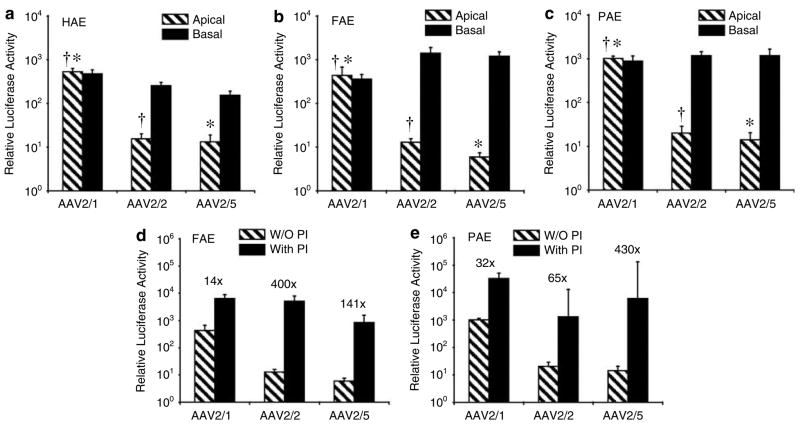Figure 1.
Comparative biology of recombinant adeno-associated virus (rAAV) transduction in human, ferret and pig airway epithelia. (a–c) Polarized air–liquid interface (ALI) airway epithelial cultures from human (HAE), ferret (FAE) and pig (PAE) were generated from tracheal tissue as described previously.21 Differentiated cultures were infected with rAAV luciferase virus pseudotyped in serotype 1, 2 or 5 capsid containing an rAAV2 viral genome (rAAV2/1, rAAV2/2, rAAV2/5). Viruses were generated using a triple plasmid transfection method as described previously.22 Infections were performed by applying 2.0 × 103 particles per cell (2 × 109 total particles per well) to either the apical or basal surface for 16 h as described previously.11 Relative luciferase activity was measured at 3 days post-infection. (d, e) ALI cultures were apically infected with 2.0 × 103 particles per cell in the presence or absence of 40 μM N-acetyl-L-leucyl-L-leucyl-L-norleucine and 5 μM doxorubicin for 16 h, as described previously22 and luciferase activity was measured at 3 days post-infection. Proteasome inhibitors (PI) were removed after 16 h following viral infection. Numbers above each data set represent the fold induction in the presence of proteasome inhibitor. Data in all panels represent the mean (± s.e.m.) relative luciferase activity (per well) from three independent experiments (N = 12 transwells for each experimental point). †,* marked comparisons indicate signficant difference as determined by the Student’s t-test.

